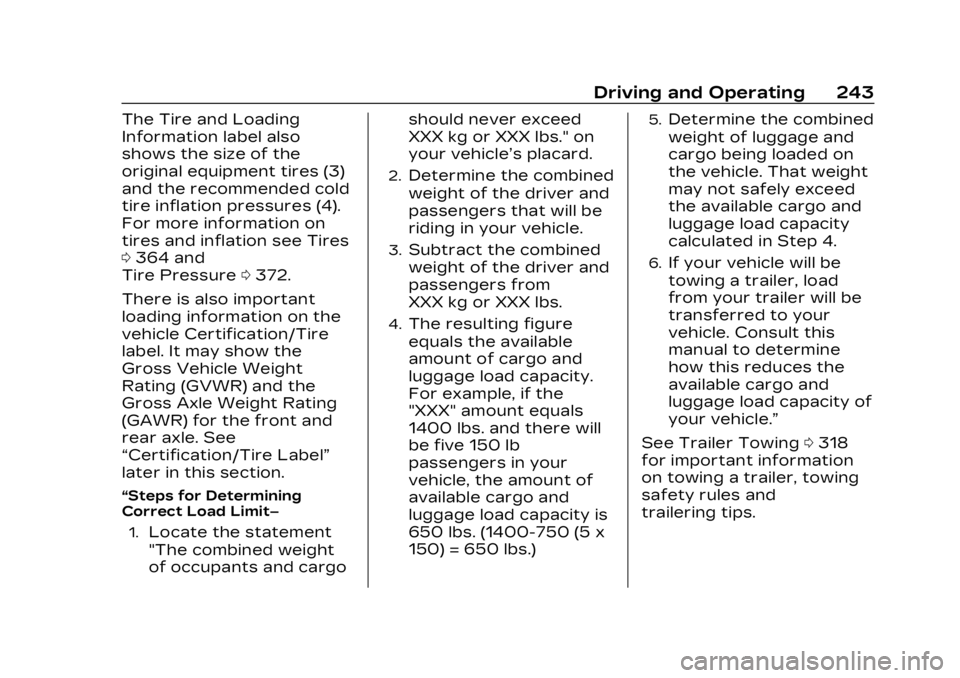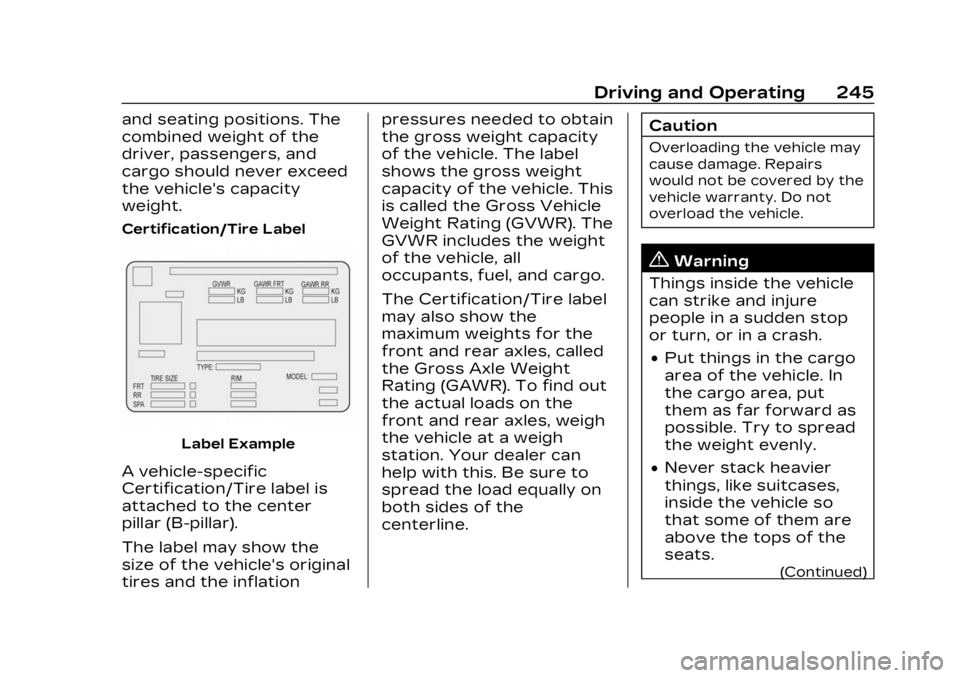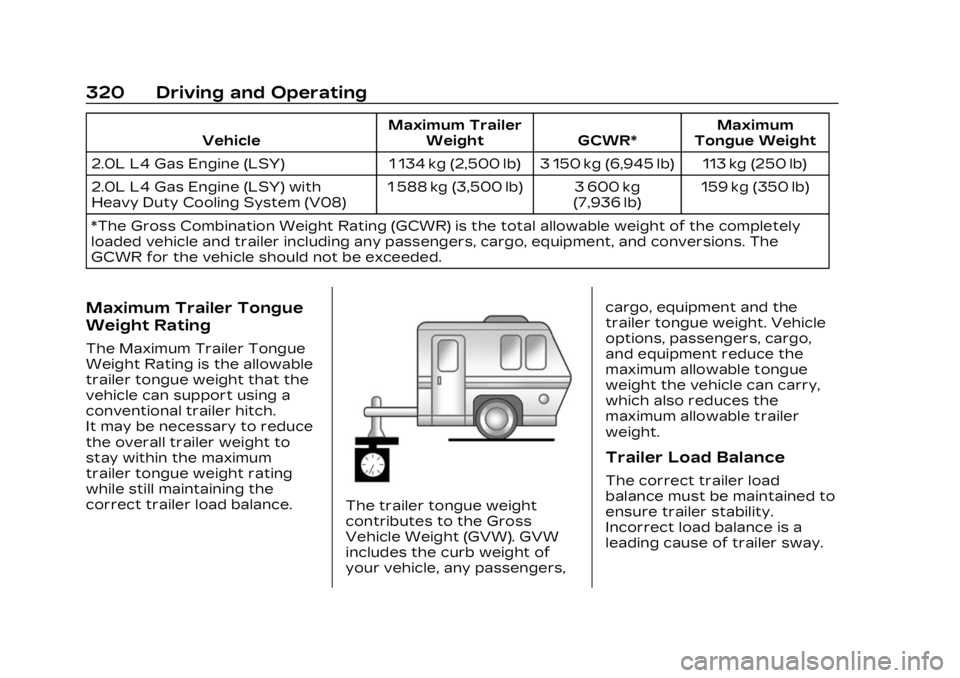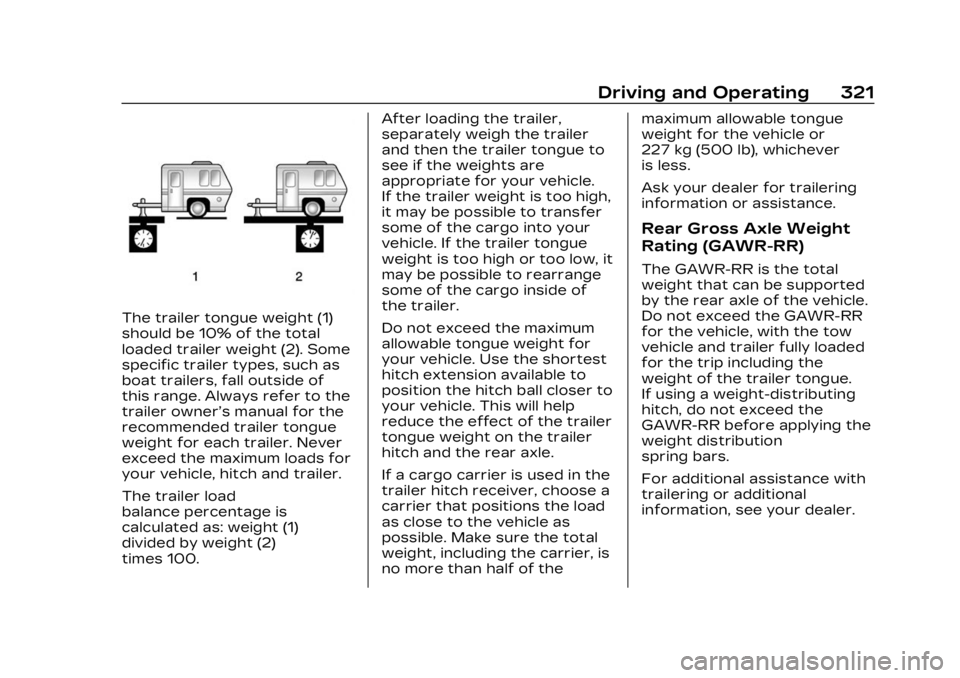weight CADILLAC XT4 2023 User Guide
[x] Cancel search | Manufacturer: CADILLAC, Model Year: 2023, Model line: XT4, Model: CADILLAC XT4 2023Pages: 476, PDF Size: 5.37 MB
Page 244 of 476

Cadillac XT4 Owner Manual (GMNA-Localizing-U.S./Canada/Mexico-
16412876) - 2023 - CRC - 3/25/22
Driving and Operating 243
The Tire and Loading
Information label also
shows the size of the
original equipment tires (3)
and the recommended cold
tire inflation pressures (4).
For more information on
tires and inflation see Tires
0364 and
Tire Pressure 0372.
There is also important
loading information on the
vehicle Certification/Tire
label. It may show the
Gross Vehicle Weight
Rating (GVWR) and the
Gross Axle Weight Rating
(GAWR) for the front and
rear axle. See
“Certification/Tire Label”
later in this section.
“Steps for Determining
Correct Load Limit– 1.
Locate the statement
"The combined weight
of occupants and cargo should never exceed
XXX kg or XXX lbs." on
your vehicle’s placard.
2.Determine the combined
weight of the driver and
passengers that will be
riding in your vehicle.
3.Subtract the combined
weight of the driver and
passengers from
XXX kg or XXX lbs.
4.The resulting figure
equals the available
amount of cargo and
luggage load capacity.
For example, if the
"XXX" amount equals
1400 lbs. and there will
be five 150 lb
passengers in your
vehicle, the amount of
available cargo and
luggage load capacity is
650 lbs. (1400-750 (5 x
150) = 650 lbs.)
5.Determine the combined
weight of luggage and
cargo being loaded on
the vehicle. That weight
may not safely exceed
the available cargo and
luggage load capacity
calculated in Step 4.
6.If your vehicle will be
towing a trailer, load
from your trailer will be
transferred to your
vehicle. Consult this
manual to determine
how this reduces the
available cargo and
luggage load capacity of
your vehicle.”
See Trailer Towing 0318
for important information
on towing a trailer, towing
safety rules and
trailering tips.
Page 245 of 476

Cadillac XT4 Owner Manual (GMNA-Localizing-U.S./Canada/Mexico-
16412876) - 2023 - CRC - 3/25/22
244 Driving and Operating
Example 1
1.Vehicle Capacity
Weight for Example 1 =
453 kg (1,000 lbs).
2.Subtract Occupant
Weight @ 68 kg
(150 lbs) × 2 = 136 kg
(300 lbs).
3.Available Occupant and
Cargo Weight = 317 kg
(700 lbs).
Example 2
1.Vehicle Capacity
Weight for Example 2 =
453 kg (1,000 lbs).
2.Subtract Occupant
Weight @ 68 kg
(150 lbs) × 5 = 340 kg
(750 lbs).
3.Available Cargo Weight
= 113 kg (250 lbs).
Example 3
1.Vehicle Capacity
Weight for Example 3 =
453 kg (1,000 lbs).
2.Subtract Occupant
Weight @ 91 kg
(200 lbs) × 5 = 453 kg
(1,000 lbs).
3.Available Cargo Weight
= 0 kg (0 lbs).
Refer to the vehicle's tire
and loading information
label for specific
information about the
vehicle's capacity weight
Page 246 of 476

Cadillac XT4 Owner Manual (GMNA-Localizing-U.S./Canada/Mexico-
16412876) - 2023 - CRC - 3/25/22
Driving and Operating 245
and seating positions. The
combined weight of the
driver, passengers, and
cargo should never exceed
the vehicle's capacity
weight.
Certification/Tire Label
Label Example
A vehicle-specific
Certification/Tire label is
attached to the center
pillar (B-pillar).
The label may show the
size of the vehicle's original
tires and the inflationpressures needed to obtain
the gross weight capacity
of the vehicle. The label
shows the gross weight
capacity of the vehicle. This
is called the Gross Vehicle
Weight Rating (GVWR). The
GVWR includes the weight
of the vehicle, all
occupants, fuel, and cargo.
The Certification/Tire label
may also show the
maximum weights for the
front and rear axles, called
the Gross Axle Weight
Rating (GAWR). To find out
the actual loads on the
front and rear axles, weigh
the vehicle at a weigh
station. Your dealer can
help with this. Be sure to
spread the load equally on
both sides of the
centerline.
Caution
Overloading the vehicle may
cause damage. Repairs
would not be covered by the
vehicle warranty. Do not
overload the vehicle.
{Warning
Things inside the vehicle
can strike and injure
people in a sudden stop
or turn, or in a crash.
.Put things in the cargo
area of the vehicle. In
the cargo area, put
them as far forward as
possible. Try to spread
the weight evenly.
.Never stack heavier
things, like suitcases,
inside the vehicle so
that some of them are
above the tops of the
seats.
(Continued)
Page 319 of 476

Cadillac XT4 Owner Manual (GMNA-Localizing-U.S./Canada/Mexico-
16412876) - 2023 - CRC - 3/25/22
318 Driving and Operating
cooling system, and brake
system before and during
each trip.
Check periodically that all nuts
and bolts on the trailer hitch
are tight.
Engine Cooling When
Trailer Towing
The cooling system may
temporarily overheat during
severe operating conditions.
See Engine Overheating0342.
Trailer Towing
Caution
Towing a trailer improperly
can damage the vehicle and
result in costly repairs not
covered by the vehicle
warranty. To tow a trailer
correctly, follow the
directions in this section and
see your dealer for
important information about
towing a trailer with the
vehicle. Trailering is different than just
driving the vehicle by itself.
Trailering means changes in
handling, acceleration, braking,
durability, and fuel economy.
Successful, safe trailering
takes correct equipment, and
it has to be used properly.
The following information has
many time-tested, important
trailering tips and safety rules.
Many of these are important
for your safety and that of
your passengers. Read this
section carefully before pulling
a trailer.Trailer Weight
{Warning
Never exceed the towing
capacity for your vehicle.
Safe trailering requires
monitoring the weight, speed,
altitude, road grades, outside
temperature, dimensions of
the front of the trailer, and
how frequently the vehicle is
used to tow a trailer.
Trailer Weight Ratings
When towing a trailer, the
combined weight of the
vehicle, vehicle contents,
trailer, and trailer contents
must be below all of the
maximum weight ratings for
the vehicle including:
.Gross Combined Weight
Rating (GCWR)
.Gross Vehicle Weight
Rating (GVWR)
.Maximum Trailer Weight
Rating
.Gross Axle Weight
Rating-Rear (GAWR-RR)
.Maximum Trailer Tongue
Weight Rating
Page 320 of 476

Cadillac XT4 Owner Manual (GMNA-Localizing-U.S./Canada/Mexico-
16412876) - 2023 - CRC - 3/25/22
Driving and Operating 319
See“Weight-Distributing Hitch
Adjustment” under Towing
Equipment 0322 to determine
if equalizer bars are required
to obtain the maximum trailer
weight rating.
See “Trailer Brakes” under
Towing Equipment 0322 to
determine if brakes are
required based on the trailer
weight.
The only way to be sure the
weight is not exceeding any of
these ratings is to weigh the
tow vehicle and trailer
combination, fully loaded for
the trip, getting individual
weights for each of these
items.
{Warning
You and others could be
seriously injured or killed if
the trailer is too heavy or
the trailer brakes are
inadequate for the load. The
vehicle may be damaged,
(Continued)
Warning (Continued)
and the repairs would not be
covered by the vehicle
warranty.
Only tow a trailer if all the
steps in this section have
been followed. Ask your
dealer for advice and
information about towing a
trailer.
Gross Combined Weight
Rating (GCWR)
GCWR is the total allowable
weight of the completely
loaded vehicle and trailer
including any fuel, passengers,
cargo, equipment, and
accessories. Do not exceed
the GCWR for your vehicle.
The GCWR for the vehicle is
on the Tow Rating Chart
following.
Gross Vehicle Weight
Rating (GVWR)
For information about the
vehicle's maximum load
capacity, see Vehicle Load
Limits0242. When calculating
the GVWR with a trailer
attached, the trailer tongue
weight must be included as
part of the weight the vehicle
is carrying.
Maximum Trailer Weight
The maximum trailer weight
rating is calculated assuming
the tow vehicle has a driver, a
front seat passenger, and all
required trailering equipment.
This value represents the
heaviest trailer the vehicle can
tow, but it may be necessary
to reduce the trailer weight to
stay within the GCW, GVWR,
maximum trailer tongue load,
or GAWR-RR for the vehicle.
Use the tow rating chart to
determine how much the
trailer can weigh, based on the
vehicle model and options.
Page 321 of 476

Cadillac XT4 Owner Manual (GMNA-Localizing-U.S./Canada/Mexico-
16412876) - 2023 - CRC - 3/25/22
320 Driving and Operating
VehicleMaximum Trailer
Weight GCWR* Maximum
Tongue Weight
2.0L L4 Gas Engine (LSY) 1 134 kg (2,500 lb) 3 150 kg (6,945 lb) 113 kg (250 lb)
2.0L L4 Gas Engine (LSY) with
Heavy Duty Cooling System (V08) 1 588 kg (3,500 lb) 3 600 kg
(7,936 lb)159 kg (350 lb)
*The Gross Combination Weight Rating (GCWR) is the total allowable weight of the completely
loaded vehicle and trailer including any passengers, cargo, equipment, and conversions. The
GCWR for the vehicle should not be exceeded.
Maximum Trailer Tongue
Weight Rating
The Maximum Trailer Tongue
Weight Rating is the allowable
trailer tongue weight that the
vehicle can support using a
conventional trailer hitch.
It may be necessary to reduce
the overall trailer weight to
stay within the maximum
trailer tongue weight rating
while still maintaining the
correct trailer load balance.
The trailer tongue weight
contributes to the Gross
Vehicle Weight (GVW). GVW
includes the curb weight of
your vehicle, any passengers, cargo, equipment and the
trailer tongue weight. Vehicle
options, passengers, cargo,
and equipment reduce the
maximum allowable tongue
weight the vehicle can carry,
which also reduces the
maximum allowable trailer
weight.
Trailer Load Balance
The correct trailer load
balance must be maintained to
ensure trailer stability.
Incorrect load balance is a
leading cause of trailer sway.
Page 322 of 476

Cadillac XT4 Owner Manual (GMNA-Localizing-U.S./Canada/Mexico-
16412876) - 2023 - CRC - 3/25/22
Driving and Operating 321
The trailer tongue weight (1)
should be 10% of the total
loaded trailer weight (2). Some
specific trailer types, such as
boat trailers, fall outside of
this range. Always refer to the
trailer owner’s manual for the
recommended trailer tongue
weight for each trailer. Never
exceed the maximum loads for
your vehicle, hitch and trailer.
The trailer load
balance percentage is
calculated as: weight (1)
divided by weight (2)
times 100.After loading the trailer,
separately weigh the trailer
and then the trailer tongue to
see if the weights are
appropriate for your vehicle.
If the trailer weight is too high,
it may be possible to transfer
some of the cargo into your
vehicle. If the trailer tongue
weight is too high or too low, it
may be possible to rearrange
some of the cargo inside of
the trailer.
Do not exceed the maximum
allowable tongue weight for
your vehicle. Use the shortest
hitch extension available to
position the hitch ball closer to
your vehicle. This will help
reduce the effect of the trailer
tongue weight on the trailer
hitch and the rear axle.
If a cargo carrier is used in the
trailer hitch receiver, choose a
carrier that positions the load
as close to the vehicle as
possible. Make sure the total
weight, including the carrier, is
no more than half of themaximum allowable tongue
weight for the vehicle or
227 kg (500 lb), whichever
is less.
Ask your dealer for trailering
information or assistance.
Rear Gross Axle Weight
Rating (GAWR-RR)
The GAWR-RR is the total
weight that can be supported
by the rear axle of the vehicle.
Do not exceed the GAWR-RR
for the vehicle, with the tow
vehicle and trailer fully loaded
for the trip including the
weight of the trailer tongue.
If using a weight-distributing
hitch, do not exceed the
GAWR-RR before applying the
weight distribution
spring bars.
For additional assistance with
trailering or additional
information, see your dealer.
Page 323 of 476

Cadillac XT4 Owner Manual (GMNA-Localizing-U.S./Canada/Mexico-
16412876) - 2023 - CRC - 3/25/22
322 Driving and Operating
Towing Equipment
Hitches
Always use the correct hitch
equipment for your vehicle.
Crosswinds, large trucks going
by, and rough roads can affect
the trailer and the hitch.
Proper hitch equipment for
your vehicle helps maintain
control of the vehicle-trailer
combination. Many trailers can
be towed using a
weight-carrying hitch which
has a coupler latched to the
hitch ball, or a tow eye latched
to a pintle hook. Other trailers
may require a
weight-distributing hitch that
uses spring bars to distribute
the trailer tongue weight
between your vehicle and
trailer axles. See“Maximum
Trailer Tongue Weight” under
Trailer Towing 0318 for
weight limits with various hitch
types. Never attach rental hitches or
other bumper-type hitches.
Only use frame-mounted
hitches that do not attach to
the bumper.
Hitch Cover
To remove hitch cover,
if equipped:
1. Remove the two fasteners on the lower tabs.
2. Pull the lower edge of the cover to about a 45 degree
angle.
3. Pull the cover downward to disengage the upper
attachments. To reinstall the hitch cover:
1. Hold cover at a 45 degree angle to the vehicle and
push the upper tabs into
the slots in the bumper.
2. Push the bottom of the cover forward until the
lower tabs line up with the
lower slots.
3. Snap the hitch cover into place by pushing the upper
corners forward.
4. Reinstall the two fasteners on the lower tabs.
Consider using mechanical
sway controls with any trailer.
Ask a trailering professional
about sway controls or refer
to the trailer manufacturer's
recommendations and
instructions.
Tires
.Do not tow a trailer while
using a compact spare tire
on the vehicle.
Page 324 of 476

Cadillac XT4 Owner Manual (GMNA-Localizing-U.S./Canada/Mexico-
16412876) - 2023 - CRC - 3/25/22
Driving and Operating 323
.Tires must be properly
inflated to support loads
while towing a trailer. See
Tires0364 for instructions
on proper tire inflation.
Safety Chains
Always attach chains between
the vehicle and the trailer, and
attach the chains to the holes
on the trailer hitch platform.
Instructions about safety
chains may be provided by the
hitch manufacturer or by the
trailer manufacturer.
Cross the safety chains under
the tongue of the trailer to
help prevent the tongue from
contacting the road if it
becomes separated from the
hitch. Always leave just
enough slack so the
combination can turn. Never
allow safety chains to drag on
the ground.
Trailer Brakes
Loaded trailers over 450 kg
(1,000 lb) must be equipped
with brake systems and with brakes for each axle. Trailer
braking equipment conforming
to Canadian Standards
Association (CSA) requirement
CAN3-D313, or its equivalent,
is recommended.
State or local regulations may
require trailers to have their
own braking system if the
loaded weight of the trailer
exceeds certain minimums
that can vary from state to
state. Read and follow the
instructions for the trailer
brakes so they are installed,
adjusted, and maintained
properly. Never attempt to tap
into your vehicle's hydraulic
brake system. If you do, both
the vehicle anti-lock brakes
and the trailer brakes may not
function, which could result in
a crash.
Trailer Wiring Harness
Basic Trailer Wiring
The trailer wiring harness is
located at the rear of the
vehicle and is tied to the
vehicle's frame. The harness
connector can be plugged into
a trailer connector available
through your dealer.
Trailer Lamps
Always check all trailer lamps
are working at the beginning
of each trip, and periodically
on longer trips.
Turn Signals When
Towing a Trailer
When properly connected, the
trailer turn signals will
illuminate to indicate the
vehicle is turning, changing
lanes, or stopping. When
towing a trailer, the arrows on
the instrument cluster will
illuminate even if the trailer is
not properly connected or the
bulbs are burned out.
Trailer Sway
Control (TSC)
Vehicles with StabiliTrak/
Electronic Stability Control
(ESC) have a Trailer Sway
Page 326 of 476

Cadillac XT4 Owner Manual (GMNA-Localizing-U.S./Canada/Mexico-
16412876) - 2023 - CRC - 3/25/22
Driving and Operating 325
manufacturers recommend
replacing tires more than six
years old.
Overloading is another leading
cause of trailer tire blow-outs.
Never load your trailer with
more weight than the tires are
designed to support. The load
rating is located on the trailer
tire sidewall.
Always know the maximum
speed rating for the trailer
tires before driving. This may
be significantly lower than the
vehicle tire speed rating. The
speed rating may be on the
trailer tire sidewall. If the
speed rating is not shown, the
default trailer tire speed rating
is 105 km/h (65 mph).Conversions and
Add-Ons
Add-On Electrical
Equipment
{Warning
The Data Link Connector
(DLC) is used for vehicle
service and Emission
Inspection/Maintenance
testing. See Malfunction
Indicator Lamp (Check
Engine Light)0126. A device
connected to the DLC —
such as an aftermarket fleet
or driver-behavior tracking
device —may interfere with
vehicle systems. This could
affect vehicle operation and
cause a crash. Such devices
may also access information
stored in the vehicle’s
systems.
Caution
Some electrical equipment
can damage the vehicle or
cause components to not
work and would not be
covered by the vehicle
warranty. Always check with
your dealer before adding
electrical equipment.
Add-on equipment can drain
the vehicle's 12-volt battery,
even if the vehicle is not
operating.
The vehicle has an airbag
system. Before attempting to
add anything electrical to the
vehicle, see Servicing the
Airbag-Equipped Vehicle 076
and Adding Equipment to the
Airbag-Equipped Vehicle 077.